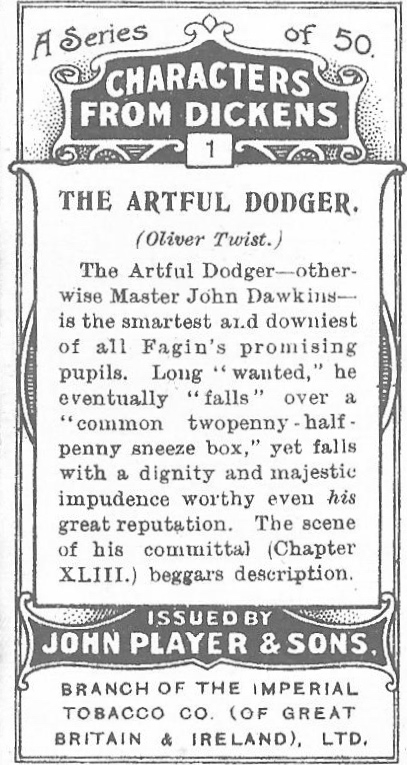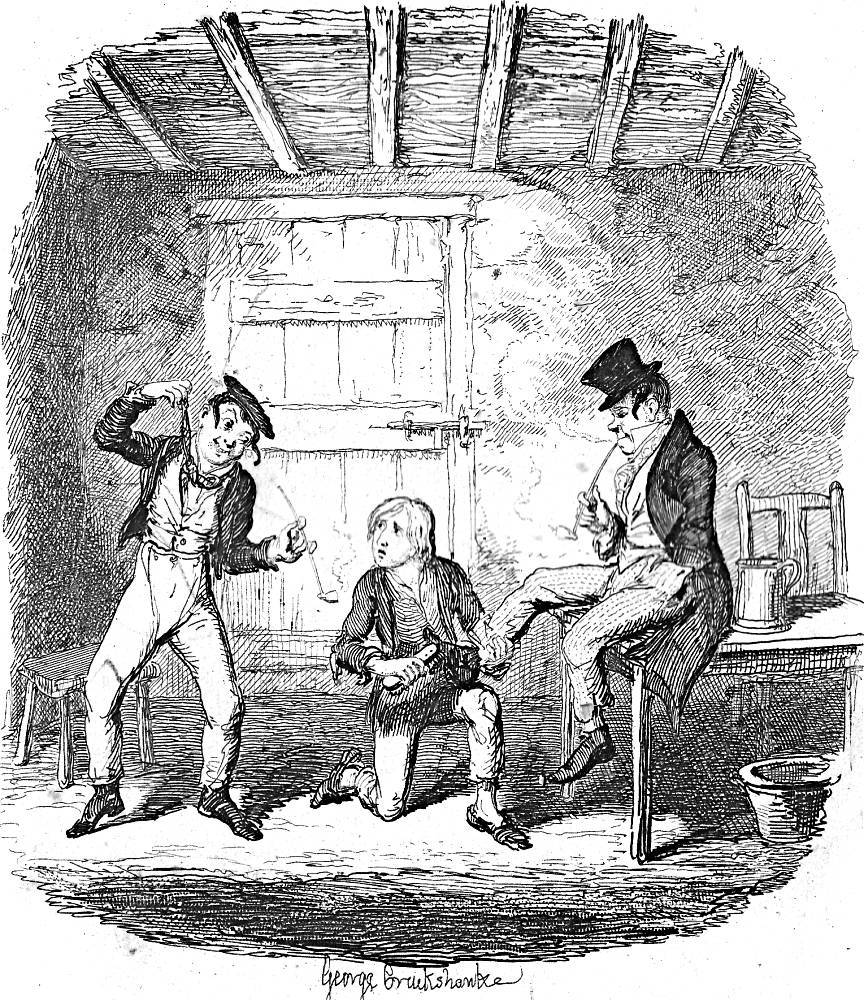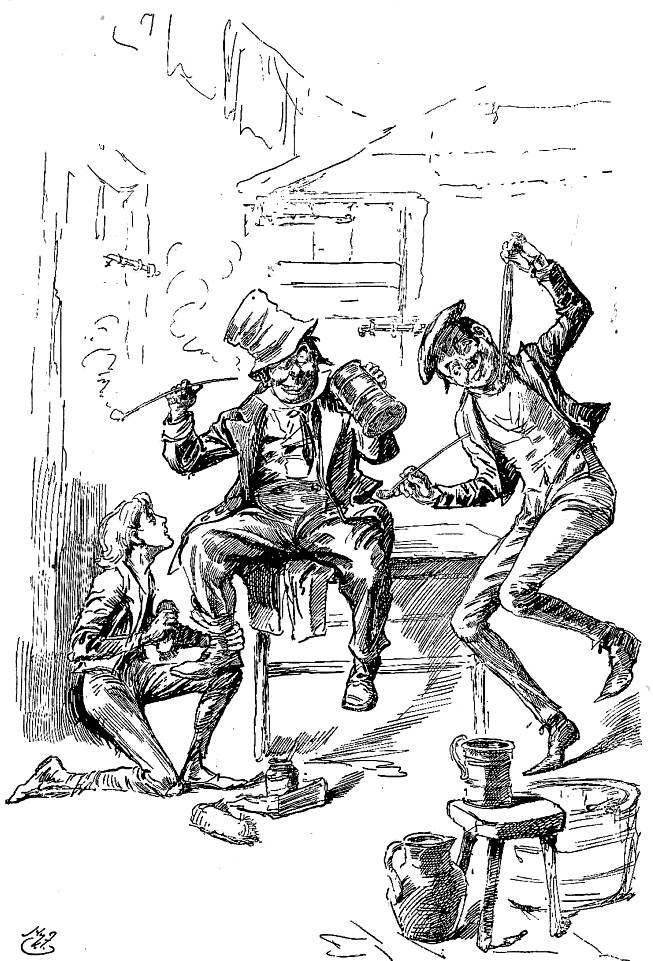

The Artful Dodger by J. Clayton Clarke ("Kyd") for the 1910 watercolour series: reproduced on John Player cigarette card no. 1: Ninety-two Characters from Dickens: The Adventures of Oliver Twist. 2 ½ inches high by 1 ¼ inches wide (6.3 cm high by 3.3 cm wide). [Click on the images to enlarge them.]
The Artful Dodger — otherwise Master John Dawkins — is the smartest and downiest of all Fagin’s promising pupils. Long “wanted,” he eventually “falls” over a “common, two Penny-half-penny sneeze box,” yet falls with a dignity and domestic impudence worthy even his great reputation. The scene of his committal (Chapter XLIII.) beggars description. [Verso over Card No. 1]
Passage Illustrated: On the seventh day, Oliver encounters a child in adult clothing
He had been crouching on the step for some time: wondering at the great number of public-houses (every other house in Barnet was a tavern, large or small), gazing listlessly at the coaches as they passed through, and thinking how strange it seemed that they could do, with ease, in a few hours, what it had taken him a whole week of courage and determination beyond his years to accomplish: when he was roused by observing that a boy, who had passed him carelessly some minutes before, had returned, and was now surveying him most earnestly from the opposite side of the way. He took little heed of this at first; but the boy remained in the same attitude of close observation so long, that Oliver raised his head, and returned his steady look. Upon this, the boy crossed over; and walking close up to Oliver, said,
‘Hullo, my covey! What’s the row?’
The boy who addressed this inquiry to the young wayfarer, was about his own age: but one of the queerest looking boys that Oliver had even seen. He was a snub-nosed, flat-browed, common-faced boy enough; and as dirty a juvenile as one would wish to see; but he had about him all the airs and manners of a man. He was short of his age: with rather bow-legs, and little, sharp, ugly eyes. His hat was stuck on the top of his head so lightly, that it threatened to fall off every moment — and would have done so, very often, if the wearer had not had a knack of every now and then giving his head a sudden twitch, which brought it back to its old place again. He wore a man’s coat, which reached nearly to his heels. He had turned the cuffs back, half-way up his arm, to get his hands out of the sleeves: apparently with the ultimate view of thrusting them into the pockets of his corduroy trousers; for there he kept them. He was, altogether, as roystering and swaggering a young gentleman as ever stood four feet six, or something less, in the bluchers.
‘Hullo, my covey! What’s the row?’ said this strange young gentleman to Oliver. [Chapter VIII, "Oliver walks to London. He encounters on the road an odd sort of young gentleman," 1846 edition, pp. 39-40]
Commentary: Characters from Dickens
Of the set of 50 cigarette cards, initially produced in 1910 and reissued in 1923, fully 15 or 30% concern a single novel, The Pickwick Papers, and other five Oliver Twist. That forty per cent of the illustrations concern these early novels attests to the continued popularity of the picaresque comic novels — and also suggests that the later, darker novels such as Our Mutual Friend and The Mystery of Edwin Drood offered little for the caricaturist, the only late characters in the series being the singularly unpleasant Silas Wegg and Rogue Riderhood from Our Mutual Friend, and Turveydrop, Jo, Bucket, and Chadband from Bleak House. Although the popular taste in "characters from Dickens" as well as in "novels from Dickens" has changed markedly over the past century, The Artful Dodger has become something of a cultural icon thanks to numerous film and stage adaptations such as the 1968 film Oliver!
Dickens and Cruikshank originally introduced Jack Dawkins in serial instalment no. 4 (May 1837) in Bentley's Miscellany. Although the commentary on the verso of Card No. 1 extols The Dodger's part in the comic trial which results in his Australian transportation — a scene so ably realised by James Mahoney in the 1871 Household Edition as "What is this?" inquired one of the magistrates. n— "A pick-pocketing case, Your. Worship.", Kyd never attempted this scene. And the present portrait of The Artful Dodger, leaning against a wall and smoking a long pipe, accords much better with the circumstances of the Barnett scene which sets up Oliver's joining Fagin's gang of pickpockets in the East End of London. See Kyd's other treatments of the street-wise, verbose Cockney pickpocket: The Artful Dodger and The Artful Dodger (c. 1900).
Relevant Illustrations from the serial and later editions (1838, 1871, 1885, and 1910)



Left: George Cruikshank's Master Bates explains a professional technicality (1838). Centre: F. W. Pailthorpe's version of Oliver's meeting the Artful Dodger at Barnett: "Hullo, my covey! What's the row?" (1886). Right: Harry Furniss's Charles Dickens Library Edition illustration The Dodger's Toilet (1910). [Click on the images to enlarge them.]

Above: James Mahoney's "Hullo, my covey! What's the row?" (The Household Edition, 1871). [Click on the images to enlarge them.]
Scanned images and text by Philip V. Allingham. [You may use these images without prior permission for any scholarly or educational purpose as long as you (1) credit the person who scanned the images and (2) link your document to this URL in a web document or cite the Victorian Web in a print one.]
Bibliography
Dickens, Charles. The Adventures of Oliver Twist; or, The Parish Boy's Progress. Illustrated by George Cruikshank. London: Chapman & Hall: 1846.
Dickens, Charles. The Adventures of Oliver Twist. Frontispieces by Felix Octavius Carr Darley and Sir John Gilbert. The Household Edition. 55 vols. New York: Sheldon & Co., 1861. 2 vols.
Dickens, Charles. The Adventures of Oliver Twist. Illustrated by Sol Eytinge, Jr. The Diamond Edition. 14 vols. Boston: Ticknor & Fields, 1867. Vol. XI.
Dickens, Charles. The Adventures of Oliver Twist. Illustrated by James Mahoney. The Household Edition. 22 vols. London: Chapman and Hall, 1871. Vol. I.
Dickens, Charles. Oliver Twist. Illustrated by Harry Furniss. The Charles Dickens Library Edition. 18 vols. London: Educational Book, 1910. Vol. III.
Hammerton, J. A. "Chapter 11: Oliver Twist." The Dickens Picture-Book. The Charles Dickens Library Edition. Illustrated by Harry Furniss. 18 vols. London: Educational Book Co., 1910. Vol. 17. Pp. 129-146.
Created 5 January 2015
Last modified 2 July 2025